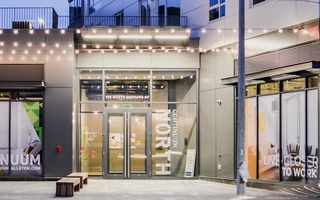As Harvard expands its efforts to construct buildings in Allston, so too does it try to construct relationships with Allston residents. To aid these efforts, Harvard has partnered with the city of Boston since 2008 to build the Harvard-Allston Partnership Fund, providing grants for community programming that benefits Allston residents. The fund recently reached a milestone, having allotted $1 million in grants to local nonprofits over the last decade.
At a Wednesday event celebrating HAPF’s milestone, Boston Mayor Martin J. Walsh praised University President Drew G. Faust for her dedication to strengthening Harvard’s relationship with Allston. He then stated that he would hold President-elect Lawrence S. Bacow to the same standards as he did Faust. As he enters the presidency this summer, Bacow should heed Walsh’s comments about being cognizant of Harvard’s relationship with Allston. He should be equally or even more supportive as Faust was in fostering a mutually beneficial and respectful partnership with the neighborhood that Harvard is entering.
We are gratified by the sentiment behind HAPF. Harvard should support the Allston community and show the residents of Allston that it is fully committed to helping them and their community in whatever way that it can. Giving funds to local nonprofits is an excellent way to display this sentiment. Nevertheless, this is not the only benefit of the program.
Nonprofits local to Allston understand the community better than any Harvard administrator or student ever could. Indeed, one of the many advantages of smaller, more local nonprofits is that they are closer to the community they serve. Another advantage is that they are more flexible and can adapt to the particular needs of any specific neighborhood—in this case Allston—better. Yet another is that they often have passionate community members involved in their work that volunteer significant amounts of time.
Giving funds to these small, local nonprofit organizations in Allston thus makes the most sense, as it will probably have the most long-lasting positive impact on the community—economic and otherwise.
For Allston residents, however, these funds are not an additional boon to a local economy, but rather a reprieve from the negative effects of gentrification.
It is almost impossible to stop an expanding university from radically changing a neighborhood such as Allston, and land values are bound to increase. Allston’s residents—in particular its poorer ones—may be especially prone to these effects as compared to residents of other Boston neighborhoods or Cambridge.
Seen as one of the last havens of affordable living that lies within the confines of the greater Boston area, 90 percent of Allston residents rent (as opposed to own) the place where they live. This constitutes one of the lowest home ownership rates in Boston, meaning Allston residents are especially susceptible to being displaced from their homes as a result of rising land values that cause increased rent.
While the sources of gentrification can be difficult to ascertain, there are some clear trends that have contributed to the phenomenon in Allston. Some of the gentrification can be attributed to Harvard’s ongoing development of the area and the anticipation of a new Harvard campus, even if that development has not yet been completed. Yet another part of Allston’s gentrification can be explained by rising land prices in downtown Boston pushing up rent prices in areas elsewhere that were previously not considered as “desirable."
Furthermore, a 2015 law that disproportionately taxes multi-family homes—often seen as one of the main ways to achieve economic stability in as a working-class family in Boston—targets lower-income families and makes them more susceptible to rising rents and displacement. Unfortunately, this law also has led to a general 13 percent increase in property tax assessments in Allston, which inevitably leads to rising rents and the further pricing out of many residents.
These factors have culminated in Allston-Brighton rents increasing by 8 percent in 2016. This is especially concerning, given that, in the same year, the average Boston rent decreased for the first time in years.
Generally, gentrification must be examined in the context of other factors. Its benefits, such as increased property tax revenue and more well-funded public schools, must also be taken into account. Neither its benefits or costs should be overemphasized. In the past, we have supported actions that we believed would cause gentrification, simply by virtue of the fact that, at times, the unavoidable costs that stem from it are not enough to halt a particular course of action.
In the case of Allston, however, we believe previous circumstances increasing land values and endangering its reputation as an affordable place to live within the city limits of Boston warrants the University to be especially cautious. University administrators in charge of the expansion therefore must make sure not to cause further gentrification within Allston that could have long-lasting negative impacts on its residents. We have previously opined that gentrification is a problem within Cambridge, but, for the reasons discussed above, this trend could be far worse in Allston.
Without caution, Harvard’s unfinished new campus could harm the residents of Allston for years to come.
This staff editorial solely represents the majority view of The Crimson Editorial Board. It is the product of discussions at regular Editorial Board meetings. In order to ensure the impartiality of our journalism, Crimson editors who choose to opine and vote at these meetings are not involved in the reporting of articles on similar topics.
Read more in Opinion
Toward A More Secure Student GovernmentRecommended Articles
-
 Harvard-Allston Task Force Discusses Housing, Construction
Harvard-Allston Task Force Discusses Housing, Construction -
 Harvard Talks Public Access to Allston Science Complex
Harvard Talks Public Access to Allston Science Complex -
 Allston Building Projects Progressing as Planned, Harvard Says
Allston Building Projects Progressing as Planned, Harvard Says -
 In Allston, Lucky 42 Offered Dibs on Housing on Harvard Land
In Allston, Lucky 42 Offered Dibs on Housing on Harvard Land -
Building Bridges in AllstonTo continue bettering its relations with Allston, the University should increase accessibility to that Harvard-Allston Task Force's meetings.













